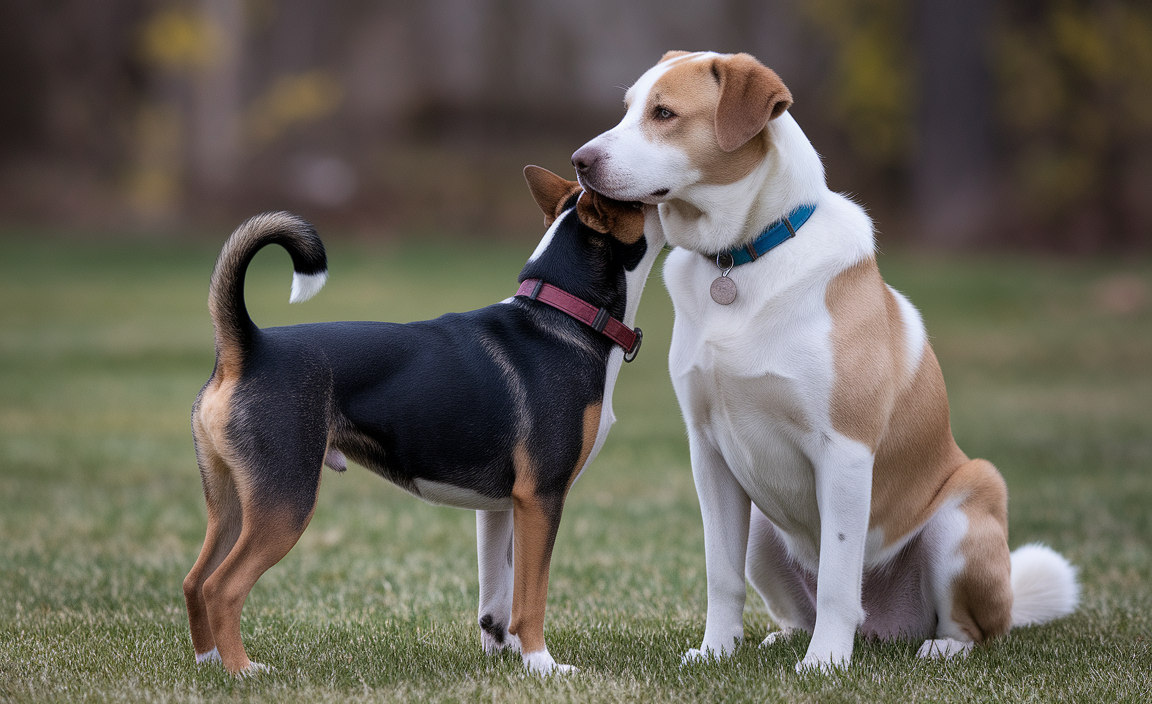Have you ever wondered how dogs communicate? Dogs have a language all their own. They use special signals to show submission. These signals help them interact peacefully with other dogs. Learning about dog submission signals naturally can help us understand them better. So, let’s dive into this exciting world!

Key Takeaways
- Dogs use body language to communicate submission.
- Recognizing dog submission signals naturally helps us understand them.
- Common signals include tail tucking and rolling over.
- Submission signals prevent dog fights and misunderstandings.
- Understanding signals strengthens human-dog relationships.
Understanding Dog Submission Signals

Dogs express submission with their bodies. This helps them avoid conflict. A submissive dog wants to show it is not a threat. When dogs meet, they look for these signals. A dog may lower its body, tuck its tail, or avoid eye contact. Rolling onto the back is another clear sign. These gestures tell other dogs, “I’m friendly and pose no harm.”
- Lowered body posture
- Tucked tail
- Avoiding direct eye contact
- Rolling onto the back
- Ears flattened against the head
Knowing these signals helps us interact with dogs better. We can tell when a dog feels comfortable or threatened. This can prevent bites and misunderstandings. It also helps us know when a dog is ready to play or needs space. Understanding these signals is key to building trust with dogs.
Fun Fact or Stats: Dogs have over 100 facial expressions, mostly using their ears.
Lowered Body Posture
Have you seen a dog lower its body? This position is a sign of submission. Dogs use it to show they are no threat. It’s like saying, “I come in peace.” This posture helps avoid fights. When another dog sees this, it knows not to attack. It can relax and approach the submissive dog calmly. Isn’t it amazing how body language can keep the peace?
Why Dogs Tuck Their Tails
When a dog tucks its tail, it signals submission. This action makes the dog look smaller and less threatening. Imagine you’re a dog meeting a new friend. Would you want to seem scary? Of course not! That’s why dogs use this signal. It helps them make friends. A tucked tail is like a handshake in the dog world.
Rolling Over to Submit
Rolling over is a big submission sign. Why do dogs do this? It’s their way of showing trust. When a dog rolls onto its back, it exposes its belly, a vulnerable spot. This says, “I trust you.” It’s a powerful gesture. It can calm down other dogs and invite play. Isn’t it fascinating how simple actions build trust?
Why Dogs Use Submission Signals

Dogs use submission signals to avoid fights and build social bonds. These signals are like manners in the dog world. Without them, dog interactions could be dangerous. Submissive signals help create harmony. They are important during first meetings or when a dog feels scared. By recognizing these signals, we can help dogs feel safe.
- Avoiding conflict
- Building trust with other dogs
- Easing social interactions
- Reducing stress in new situations
- Encouraging play and friendship
Understanding these signals helps us respond appropriately. We can keep dogs safe and happy. It also helps in training, as we can tell when a dog feels stressed. Recognizing these signals is an important part of being a responsible dog owner.
Fun Fact or Stats: Dogs have been our friends for over 15,000 years!
Preventing Dog Fights
Why do fights happen between dogs? Often, it’s because they don’t understand each other. Submission signals help prevent this. By showing submission, a dog says, “I don’t want to fight.” This calms the other dog. They can sniff each other and learn to be friends instead. Isn’t it great how these signals keep peace?
Building Trust with Other Dogs
Trust is important in the dog world. Submission signals help build it. Imagine meeting a new dog. You’re nervous, right? But then the other dog lowers its body and you see its gentle eyes. Suddenly, you feel safe. That’s what submission signals do. They help dogs trust each other and make new friends.
Submission in Stressful Situations
Dogs also use submission signals when they feel stressed. A loud noise or new place can be scary. What do dogs do? They show submission signals to say, “I need space.” This tells other dogs and humans, “Please be gentle with me.” Isn’t it smart how dogs communicate their needs like this?
| Signal | Meaning | When Used | Result |
|---|---|---|---|
| Tucked Tail | Submission | When meeting new dogs | Reduces tension |
| Lowered Body | No threat | During play | Invites approach |
| Eye Aversion | Respect | During greetings | Avoids conflict |
| Rolling Over | Trust | When relaxed | Builds bonds |
How to Respond to Submission Signals
Knowing how to respond to dog submission signals naturally is important. When a dog shows submission, it looks for a calm response. We should be gentle and welcoming. This encourages the dog to feel safe and happy. Try using soft voices and slow movements. It’s important not to scare the dog. A calm response shows the dog it’s safe to be around you.
- Stay calm and relaxed
- Use a soft voice
- Avoid sudden movements
- Give the dog some space
- Offer gentle pats or treats
By responding correctly, we can help build trust with the dog. This trust is key to a strong bond. It also helps in training and socializing the dog. Knowing how to react makes the dog feel secure and loved.
Fun Fact or Stats: Dogs can sense our emotions through our voice tones!
Calming an Anxious Dog
Seen a dog looking scared? They might be showing submission signals. How should we react? Calmly. Use a soothing voice. Avoid sudden moves. Give the dog space. This shows that you’re not a threat. The dog will feel safer and start to relax. Isn’t it wonderful how we can help them feel better?
Building Trust and Friendship
Want to be a dog’s best friend? Respond to its signals. When a dog shows submission, it’s inviting friendship. Be gentle and respectful. Show you understand its language. Over time, you’ll gain its trust. This is how lifelong friendships with dogs begin. Isn’t it great how understanding leads to friendship?
Using Patience and Understanding
Patience is key in building dog relationships. Sometimes, dogs need time to adjust. They might show submission signals when unsure. Be patient and understanding. Give them time to warm up. With kindness, they’ll soon come around. Isn’t it amazing how patience can unlock a dog’s affection?
The Role of Submission in Dog Training

Submission signals are important in dog training. Training becomes easier when we understand these signals. A dog may show submission to indicate readiness to learn. Recognizing this can make training sessions more effective. Trainers look for these signals to guide their approach. Knowing when a dog is ready to learn helps in planning lessons.
- Identifies readiness to learn
- Helps in planning training sessions
- Builds a positive training environment
- Improves dog’s confidence
- Strengthens dog-trainer bond
Trainers use submission signals to adjust their methods. They can tell when a dog is overwhelmed or comfortable. This knowledge helps in designing lessons that suit the dog’s needs. It also ensures positive training experiences for dogs.
Fun Fact or Stats: Dogs can learn over 100 words and gestures!
Recognizing Learning Signals
How do we know when a dog is ready to learn? Look for submission signals. A relaxed dog is ready for new things. Its body language tells us it’s prepared. Recognizing these signals helps in knowing when to start or pause training. Isn’t it clever how dogs communicate readiness?
Creating a Positive Environment
A positive training environment encourages learning. Submission signals help create this atmosphere. When a dog shows submission, it feels safe and open to new things. Trainers can use this to their advantage. By ensuring the dog feels secure, they can make learning fun. Isn’t it fantastic how safety leads to success?
Building Trainer-Dog Relationships
Training isn’t just about commands. It’s about relationships. Submission signals play a role here. They show when a dog trusts its trainer. This trust is crucial. It makes training smooth and enjoyable. Over time, submission signals help strengthen this bond. Isn’t it wonderful how trust and understanding create great teams?
Conclusion
Understanding dog submission signals naturally helps us connect with them. These signals are essential for peaceful interactions. Recognizing them strengthens our bond with dogs. By learning this dog language, we can ensure their safety and happiness. Isn’t it incredible how these simple gestures speak volumes?
FAQs
Question: How do dogs show submission?
Answer: Dogs show submission with body language. Common signals include tail-tucking and eye-aversion. They may also lower their bodies or roll over. These gestures say they are not a threat. Understanding these helps us communicate better with them.
Question: Why is submission important for dogs?
Answer: Submission helps dogs avoid conflicts and build social bonds. It allows them to communicate peacefully. Recognizing submission signals improves interactions. It ensures safety and harmony among dogs. Understanding this is crucial for dog owners.
Question: Can humans learn dog submission signals naturally?
Answer: Yes, humans can learn these signals by observing dogs. Watching their interactions teaches us. We can recognize submission signals naturally through practice. This knowledge improves our relationships with dogs. It makes us better pet owners.
Question: What do I do if a dog shows submission?
Answer: Respond calmly and gently. Use a soft voice and slow movements. Give the dog space. This shows you are not a threat. It helps build trust and strengthen your bond. This gentle approach ensures a positive interaction.
Question: Are submission signals used in dog training?
Answer: Yes, they play a big role. Trainers use these signals to assess readiness. Submission signals indicate when a dog is ready to learn. Recognizing them helps in planning effective sessions. They ensure a safe and positive training environment.
Question: Can submission signals prevent dog fights?
Answer: Absolutely. Submission signals communicate peaceful intentions. They prevent misunderstandings between dogs. Recognizing these signals helps defuse tension. It allows dogs to interact safely. This understanding is key to avoiding fights.
Meet Elyse Colburn, the devoted canine companion and storyteller behind the enchanting world of “Tales, Tails, and Adventures Unleashed.” A passionate dog enthusiast with a heart full of paw prints, Elyse Colburn shares heartwarming tales and insightful adventures, celebrating the joy, loyalty, and endless antics that make every dog a true hero. Join Elyse Colburn on this tail-wagging journey, where every post is a love letter to our four-legged friends.





